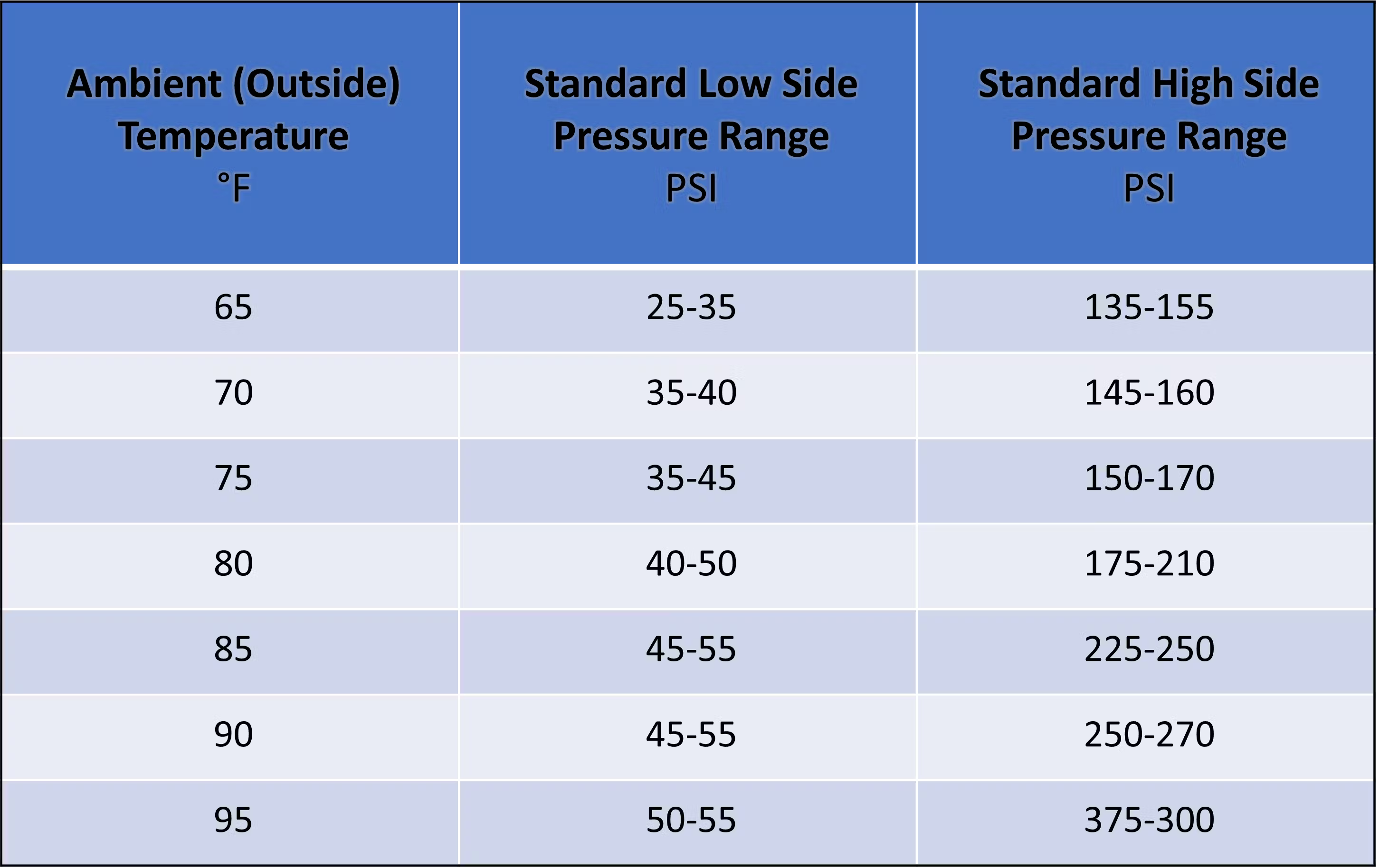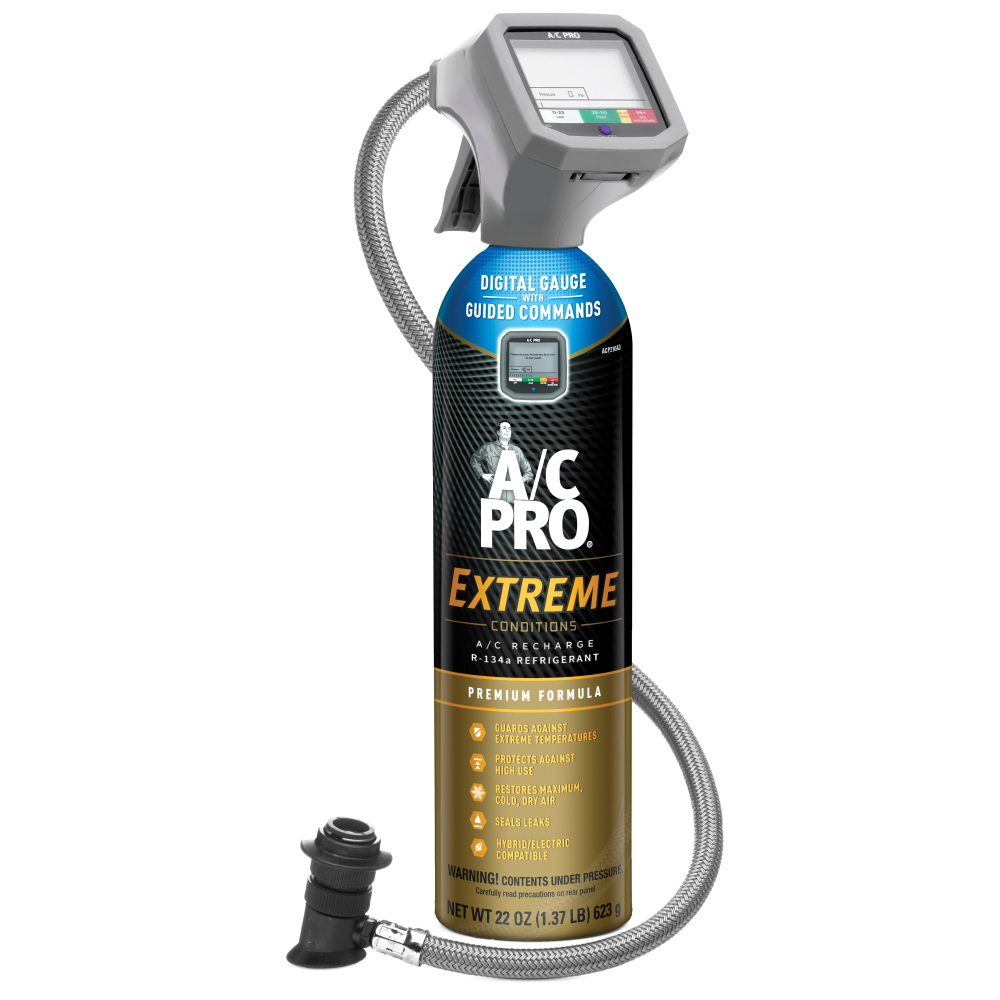The ABCs of Automotive A/C Recharge
Your air conditioning (A/C) system may seem pretty complicated, if you don’t already have a basic understanding of how it works. At A/C Pro® we help folks bring back the cold with our line of quick, and easy to use, all-in-one auto A/C Pro® recharge products.
We encourage drivers to get to know their cars, how they work, and how they can make repairs themselves - don’t be afraid to pop open the hood and get to know your vehicle!
A/C Pro® is here to give you a better understanding of how the different parts of your A/C system work together to bring you that ice-cold air.
In this cheat sheet of all things to do with your car’s A/C, we will cover:
- Ambient Temperature
- Blower Motor
- Compressor
- Desiccant
- Evaporator
- Freezing up
- Gauge
- Illegal
- J2776 Standard
- Kilopascal
- Low-Pressure Service Port
- Model Year/Make
- New Refrigerant
- Orifice Tube
- PSI
- Quick and Easy
- R-134a
- Schrader Valve
- Thermostatic Expansion Valve
- Undercharged
- Vacuum Pump
- Worry-Free
- Excess
- YouTube
- Zero Pressure
Ambient Temperature
The temperature of the air around your vehicle that your A/C system needs to cool, in order to make you comfortable.
Blower Motor
The blower motor forces air through your car’s vents. You can control the speed of the motor through switches, buttons, and dials on the dashboard. The motor and fan assembly are mounted near the evaporator, which draws air from outside or inside the car.
Compressor
The compressor is the heart of the A/C system. It’s a pump that increases refrigerant pressure and temperature. Low-pressure refrigerant gas from the evaporator enters the compressor and is compressed into a hot, high pressure gas (compressors can’t compress refrigerant in a liquid state) as it travels to the condenser.
Desiccant
Desiccant is a hygroscopic agent that can dry or remove moisture through absorption. A desiccant bag can be found in the receiver-drier, in vehicles with a Thermal Expansion Valve (TXV) system, or in the accumulator for orifice tube systems.
Evaporator
The evaporator removes heat and moisture from the warm air coming from the passenger compartment. In the evaporator, cooler liquid refrigerant changes to a gas as it absorbs heat.
Freezing Up
An air conditioning system can freeze up and ice over. The culprit? Either the unit is low on refrigerant, or there is an airflow problem. Things like a dirty air filter or blocked evaporator coil can cause this restriction.
Gauge
A gauge is a critical tool for recharging your vehicle’s A/C system. The A/C Pro® gauge reads the pressure in your A/C system and provides instant and accurate feedback on your system’s refrigerant level. The premium coupler easily connects to your car’s low-side pressure port.
High-Pressure Service Port
The high-side service port services the high-pressure side of the system, and routes high-pressure refrigerant gas and liquid through the compressor, condenser, receiver-drier and expansion valve.
Do not use your A/C Pro® recharge kit on the high-pressure side, (save this for the low-pressure port).
How can you tell the difference between high-pressure and low-pressure ports?
The high pressure line is usually smaller in diameter has a shorter pressure port valve, shorter in comparison to the low pressure port. To make it foolproof, our A/C Pro® recharge hoses are designed to only connect to the correct port.
Illegal
Is it illegal to handle refrigerant yourself?
Not at all. - While section 609 of the EPA’s Clean Air Act states that technicians must be certified to repair or service, this does not apply to consumers simply adding refrigerant to their vehicles.
Some older refrigerants have been removed from the market and require permits or licenses, but A/C Pro® is safe and easy to use. The R-134a and R-1234yf used in cars today (and in cans of A/C Pro®) is considered safe for anyone to use – it can be bought off the shelf at most auto parts stores and major retailers.
J2776 Standard
The SAE Standard J2776 sets a maximum level of 40 ppm for unsaturated impurities in R-134a. Our A/C Pro® refrigerant meets this standard.
What does SAE Standard J2776 mean?
Double bonds in unsaturated molecules are more chemically reactive than single bonds, which increases the likelihood that a refrigerant will contain contaminants, contributing to the formation of system sludge. Impure refrigerants are harmful to a cooling system and can cause mechanical problems - resulting in a loss of cooling and the need for expensive repairs. A/C Pro® has high purity standards to eliminate the problems impurities can cause.
Kilopascal
The pascal (Pa) or kilopascal (kPa) as a unit of pressure measurement is widely used throughout the world in countries that use the imperial measurement system. It has largely replaced pounds per square inch (psi) unit, in countries outside of the United States. 1 kilopascal is equivalent to 0.145037738 pounds per square inch.
Low-Pressure Service Port
The low-pressure port is where you connect your A/C Pro® to the A/C system to recharge it, or seal leaks with Super Seal.
The exact location of the port varies between car models, but it runs from the compressor back towards the passenger compartment – it’s the thicker of two metal lines coming out of the compressor. On this line you’ll find a valve covered by a plastic cap – unscrew to access the service port.
You can be certain you’ve found the correct port by simply attaching the coupler on the end of the A/C Pro® hose to it. If it’s the low-pressure service port, the connector will easily snap on and lock into place.
Model Year/Make
The car model year and make will affect the exact location of the low-pressure port.
New Refrigerant
R-1234yf (or HFO-1234yf) is a relatively new refrigerant that’s starting to be used in new cars. It was developed to meet the European 2011 directive 2006/40/EC, which requires that all new car platforms for sale in Europe must have use a refrigerant with a Global Warming Potential (GWP) of below 150.
R-1234yf is significantly less harmful on the environment. With a GWP of 4, it has much less damage potential than R-134a with a GWP of 1430.
Orifice Tube
The orifice tube is a metering device that restricts the flow of refrigerant to the evaporator. The restriction changes the liquid refrigerant from high pressure to low pressure.
A metal mesh screen catches debris that may be traveling through the system. As the orifice tube does not meter refrigerant by temperature, the liquid can pass through the evaporator and on to the compressor.
An accumulator accompanies the orifice tube to prevent any liquid refrigerant from entering the compressor, to avoid damaging this component (compressors only compress gas).
PSI
PSI or “pounds per square inch” relates to pressure when it comes to recharging – these are the numbers you see along the outside of your A/C Pro® gauge face.
When adding refrigerant, it’s important to ensure the A/C system pressure is within the correct range. Having too much pressure is just as bad (or even worse) as having too little refrigerant.
A/C Pro® gauges will show the correct pressure range for that temperature. If you stay within that range and don’t overfill, you can enjoy comfortably cold air!
Quick and Easy
A/C Pro® is super simple to use - it’s been specifically designed to be as close to “foolproof” as possible. Everything you need to recharge your car comes in a single can of A/C Pro® – no additional tools required.
Anyone can use A/C Pro® - even if you know nothing about how car A/C works! You need zero tools, or mechanical experience – it’s literally one of the simplest car repairs you can do.
A single can of A/C Pro® recharges the system with R-134a, seals leaks, eliminates corrosive moisture, and replaces lost lubricant — all in just 10 minutes.
R-134a
R-134a is a refigerant - the ‘R’ stands for “refrigerant”, and the numbers and letters identify which specific refrigerant it is.
A refrigerant is a liquid or a gas with a very low boiling point. Where water normally boils at 212 degrees Fahrenheit (and freezes at 32 degrees), a refrigerant like R-134a boils at 15 degrees below zero (and freezes at -154).
Schrader Valve
Schrader valves of varying diameters are used on many refrigeration and air conditioning systems to allow servicing, including recharging, with refrigerant. The spring-loaded valve itself is recessed inside a metal stem found inside both the high and low side charging ports. When recharging with A/C Pro®, our quick-connect couple depresses the metal stem allowing refrigerant to flow from the can into your vehicle’s A/C system.
Thermostatic Expansion Valve
In a Thermostatic Expansion Valve (TXV), like the orifice tube system, meters control the flow of refrigerant. This restriction reduces refrigerant pressure and cools it as it enters the evaporator.
Unlike the orifice tube system it controls the flow of refrigerant by sensing evaporator outlet-tube temperature and pressure, to regulate the flow of refrigerant into the evaporator.
Undercharged
When an A/C system is low on refrigerant, it loses its ability to cool the air in the car. A proper charge is critical to optimizing your A/C’s performance - an undercharged A/C system is a major cause of A/C compressor failure.
Low refrigerant means poor lubrication (lubricant flows through the system with refrigerant), so not only will you be sweaty, but you’ll be causing damage to a pretty expensive component.
A/C Pro® can fix your undercharge problem, save you time, money, and the unfortunate side effects of Sweaty Back Syndrome.
Vacuum Pump
Your system only needs to be vacuumed if you have replaced a component part in the system - to remove excess air and moisture that has been introduced while the system was open.
How to vacuum A/C system?
There’s no need to vacuum out the system if the issue is just a small leak, or lack of refrigerant, as it is a closed system operation. A/C Pro® has additives that condition the rubber components (that are typically responsible for leaks) and eliminate moisture in the system.
Worry-Free
Need a little extra help? Don’t worry, here at A/C Pro®, we’ve got you covered. Our customer support team is there to help.
Our toll-free line is open 7 days a week during the summer season to answer any questions about you’re A/C Pro® Recharge. Reach out to 1-888-318-5454 between 8 AM to 7 PM (CST) Monday to Friday or 10 AM to 3 PM (CST) on the weekends.
Not up for talking? Fill out our Ask the Pro form and a customer support member will reach out at a time that works for you.
Excess
“More is better” doesn’t apply to charging your vehicle’s A/C system. Adding excessive amounts of refrigerant beyond your auto A/C capacity won’t give you colder air and can be damaging to the system’s performance in the long run.
YouTube
Some people are visual learners. What better way to learn the ins and outs of your A/C than by watching a video? It’s the next best thing to being under the hood.
We have a YouTube channel dedicated to showing you how to find your low-pressure port, how to use A/C Pro® and how to recharge car A/C as well as great money-saving repairs you can DIY. Besides having great content, we also answer your A/C questions!
Zero Pressure
We often get asked why the pressure “drops” when adding refrigerant: “I pulled the trigger and my A/C dropped to 0 PSI and when I let go it’s 30 PSI, is that normal?”. The reality is when you’re pulling the trigger, the gauge is not reading your system’s pressure.
To get the actual pressure reading, you need to release the trigger every few seconds and be sure the compressor is cycled on, to get the low side pressure reading on your vehicle.







